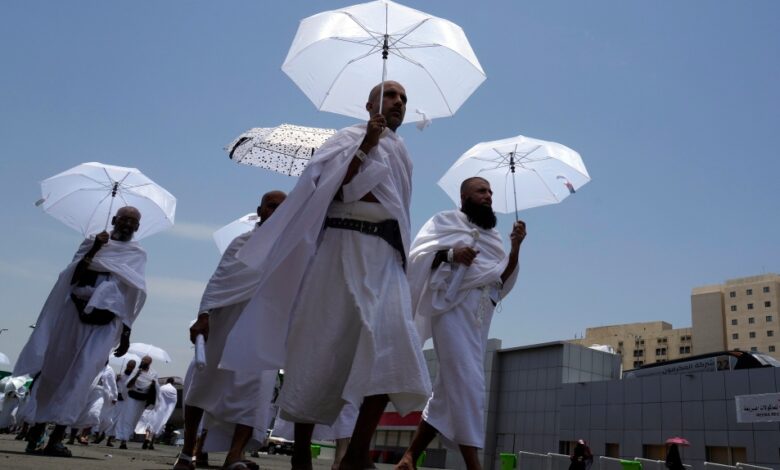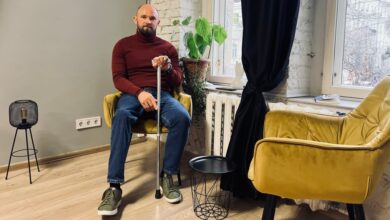Hajj Essentials: From Sun Hats to Shoe Bags, A Guide to Equipment for the Muslim Pilgrimage

MECCA, Saudi Arabia –
Straw hats, shoulder bags and folding chairs: these are just some of the essentials that Muslims take with them on the Hajj pilgrimage.
Spiritually, the five-day hajj is awe-inspiring for the believers, an experience they say brings them closer to God and to the entire Muslim world.
Physically it is debilitating. Pilgrims walk for hours outside in blazing heat around sacred sites in Mecca and the surrounding desert. They are caught in an unimaginable and overwhelming crowd, all trying to get to the same place. Barriers directing traffic mean that if you miss your turn, you may still have to walk for hours to get where you want to be.
So the more than 2 million pilgrims are not only learning the complicated rules for correctly performing the rituals, which began Monday. They also pick up handy tips and tricks of the trade for getting by, learned from other hajis – as those who have completed the pilgrimage are called.
Here’s a look at what they think is essential gear.
WHAT TO WEAR
Dress for the heat, as daytime temperatures regularly soar above 40 degrees Celsius (104 degrees Fahrenheit). Most of the rituals take place outside in the desert, including climbing the Mount of Mercy and stoning the Jamarat, a row of pillars representing the devil.
Sun hats are key. Pilgrims often choose wide-brimmed straw hats or even cowboy hats. Umbrellas of all colors are everywhere. Some balance their prayer mats on their heads or the canopies of umbrellas.
All men are required to wear plain white robes with no stitching, a rule designed to unite rich and poor. Women are required to forego beauty products and cover their hair, but have more leeway to wear fabrics from their native lands, resulting in a colorful display of Islam’s multiculturalism.
When it comes to footwear, it is best to wear something that is durable for the long walks, but also slips on and off easily, as pilgrims are required to take off their shoes before entering the Grand Mosque of Mecca.
Sandals are sensible, but some pilgrims say it’s also best to wear socks, as the mosque’s marble floor can be surprisingly cold as they circumnavigate the Kaaba seven times.
WHAT TO WEAR
Some sort of daypack is essential for carrying food, water, sunscreen and other items. But backpacks can be a hassle when you’re crammed shoulder to shoulder.
Much more popular are crossbody bags that you can reach without turning around.
Many pilgrims also carry a separate bag or drawstring bag for their shoes. Usually at mosques you can leave your shoes with a servant at the entrance, but with hundreds of thousands at the Grand Mosque, that’s a surefire way to lose your shoes, or at best waste a long time trying to get them back. It would also mean leaving the same way you entered, which isn’t always possible if the crowd leads you in a different direction.
Umaima Hafez, a five-time hajah from Egypt, tackles like a pro.
Sitting on her portable plastic stool, she reaches into her large backpack and pulls out a blanket, homemade granola and crackers, a travel towel that she wets and puts on her head when it gets hot, an extra thick prayer mat — for her knees — and some medications. The stool also fits in the bag. She will wear it during Hajj and then leave it for someone else to use.
She insists her bag is not heavy. “Everything is beautiful and easy with God. ΓǪ And people spend a lot of water and food here.”
Hassan Hussain, a 24-year-old first pilgrim from Britain, also went for a maximum approach. His bag contains his phone, charging cable, power bank, sunglasses, water bottle, UK and Saudi currency, bank cards, his shoe bag, a prayer mat and moisturizing face mist.
He said his sister, who did Hajj last year, told him what to bring. His advice to other pilgrims is to pack.
“You don’t know when you need things,” he said. “Maybe the person next to you needs things. Just take everything with you and work it out as you go.’
Ali Ibn Mousa, on the other hand, a 30-year-old Russian and a father of seven, goes for agility and speed, so he stays light.
His drawstring bag contains only his phone and his Pilgrim ID. He is more interested in what he will bring back from the Hajj, and says he is looking for a second wife in addition to the spiritual journey.
“If I had a heavy bag, I wouldn’t be able to do some of the things I want to do,” he said. “That’s why I bring a small bag that is easy to carry so I can run in” while circling the Kaaba.
CAMPOUT CHECKLIST
The gigantic streams of pilgrims travel back and forth between holy sites spanning more than 10 miles from the Grand Mosque to the Mount of Mercy, or Mount Arafat, in the desert. Even within a single ritual site, it can take much of the day to walk from one end to the other, such as Mina, where pilgrims stay in one of the world’s largest tent camps and the pillars representing the devil, stone.
A pilgrim must be prepared to be stuck in a spot outside for ages, waiting for a transport to arrive or a crowd to move away, sometimes in the middle of the night.
Ikram Mohammed’s supermarket in Makkah sells camping essentials such as lightweight tents, sleeping mats and collapsible water bags.
“They buy dried fruits and nuts, biscuits, chips. Anything they can easily consume on the go that doesn’t require refrigeration or utensils,” Mohammed said. A special department specializes in perfume-free toiletries, in accordance with the perfume ban.
Mohammed also sells souvenirs for pilgrims to take home, everything from chocolate and sweets to water from the sacred Zamzam spring near the Kaaba.
Another popular item: pain relief cream for aching joints.




